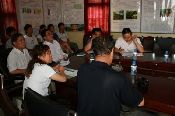| MEDALUS I-III |
Mediterranean Desertification and Land Use |
| Time span: |
Overall: 1991 - 1999 (phase I: January 1991 - December 1992; phase II: January 1993 - September 1995; phase III: January 1996 - June 1999) |
| Aim: |
The emphasis of the research has changed in each phase and the partners also changed to reflect this. The ultimate goal is the understanding, prediction and mitigation of Desertification in the Mediterranean countries of the European Union. |
| Description: |
Phase I: The first objective of MEDALUS I was to develop a physically-based model to describe environmental processes operating at the hillslope scale. The model was supplied with data for development and verification from seven field sites located along the northern edge of the Mediterranean. Each of the field sites had the same experimental design and each monitored the same set of 55 parameters. Climate change studies looked at trends in past rainfall and temperature over the entire Mediterranean Basin and general circulation model scenarios were used to generate future climate scenarios also to be used in the hillslope model. Remote sensing was used to develop vegetation and lithological maps over much larger areas. Socio-economic studies set possible future land use changes in the context of past changes from pre-historic to recent times.
Phase II: Many of the activities started in MEDALUS I were continued into MEDALUS II and other topics were started. The programme of field monitoring was continued and the number and range of special field site studies was expanded. A new, physically-based model (MEDRUSH) was developed, designed to operate at the river basin scale and to simulate landscape changes over hundreds, instead of tens, of years. The climate work continued and expanded into the analysis of extreme events. New investigations were started into ways in which the effects of desertification might be mitigated, using alternative land uses or plant cover strategies. However the major development was the establishment of three target areas, large river basins (in Spain, and two in Italy) in which to develop all the thematic research to a regional scale.
Phase III: The first objective was to build on the core field and ecological studies, and to consolidate and apply the models in as many areas as possible. The second objective was to develop and apply a methodology for the use of desertification indicators to identify environmentally sensitive areas at the local level. The same methodology was used in all four areas to derive four indicators of soil, climate, vegetation and management quality. The combination of all four indicators gave the environmental sensitivity. In its third objective, MEDALUS III explored opportunities to address the problems of desertification at a Mediterranean-wide large scale. A regional degradation index was developed for the whole Mediterranean region based on potential soil erosion, with inputs of land cover from remote sensing and climate. The fourth objective was to examine some of the important physical processes operating within ephemeral channels and rivers.
|
| Countries: |
Field sites differed per phase (see description). Phase I had 17 partners, phase II 44 and phase III 30. |
| Website: |
http://www.medalus.demon.co.uk |
|



